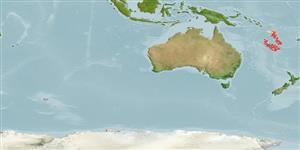Elasmobranchii (hajar och rockor) (sharks and rays) >
Carcharhiniformes (Ground sharks) >
Pentanchidae (Deepwater catsharks)
Etymology: Galeus: galeos, a small shark or dogfish according to Aristotle and others. (See ETYFish); priapus: Named for Priapos, Greek god of reproduction, referring to its long claspers. (See ETYFish).
More on authors: Séret & Last.
Environment: milieu / climate zone / depth range / distribution range
Ekologi
marina bentopelagisk; djupintervall 620 - 830 m (Ref. 76879). Subtropical; 13°S - 24°S, 163°E - 171°E (Ref. 76879)
Pacific Western Central: New Caledonia and Vanuatu. Known from the marginal slopes off southern New Caledonia, south of the Loyalty Islands Ridge and north of the Norfolk Ridge in 620–830 m depth and off Espiritu Santo Island (Vanuatu) in 262–352m depth (Ref. 76879).
Size / Vikt / Age
Maturity: Lm ? range ? - ? cm
Max length : 44.6 cm TL hane/ej könsbestämd; (Ref. 76879); 38.8 cm (female)
Short description
Bestämningsnycklar | Morfologi | Morfometri
A small, slender Galeus with the following combination of characters: claspers extremely long
and slender in adult males, distal tips extending to near anal origin or beyond, their outer length 9.2–11.2% TL, 7.2–8.7 times base width; clasper without hooks or spiny denticles; exorhipidion greatly elongated, about 4 times spiracle length when fully developed; anterior inner margin of pelvic fin not fused to clasper; anal fin relatively small, length 9.8–12.0% TL; posterior anal-fin margin 4.7–5.9% TL, 1.4–1.8 in anterior margin of second dorsal fin; prepectoral length relatively short, about 17.8–19.4 %TL; labial furrows moderately long, not confined to mouth corners; enlarged denticle crest of upper caudal fin originating almost over origin of ventral caudal lobe, no abrupt demarcation between denticles of crest and those of caudal peduncle; denticles forming 2–5 central rows of denticles between larger oblique lateral rows near crest origin; no subcaudal crest; anterior margin of pectoral fin black; anterior half of dorsal fins almost entirely dark or dusky; precaudal centra 81–86 (Ref. 76879).
Life cycle and mating behavior
Maturities | Reproduktion | Spawnings | Egg(s) | Fecundities | Larver
Séret, B. and P.R. Last, 2008. Galeus priapus sp. nov., a new species of sawtail catsharks (Carcharhiniformes: Scyliorhinidae) from New Caledonia. Zootaxa 1813:19-28. (Ref. 76879)
IUCN Red List Status (Ref. 130435)
Threat to humans
Harmless
Human uses
Verktyg
Special reports
Download XML
Internet-källor
Estimates based on models
Preferred temperature (Ref.
123201): 5.6 - 6.8, mean 6.1 °C (based on 6 cells).
Phylogenetic diversity index (Ref.
82804): PD
50 = 0.5000 [Uniqueness, from 0.5 = low to 2.0 = high].
Bayesian length-weight: a=0.00355 (0.00176 - 0.00714), b=3.09 (2.91 - 3.27), in cm total length, based on LWR estimates for this (Sub)family-body shape (Ref.
93245).
Trofisk nivå (Ref.
69278): 4.0 ±0.2 se; based on size and trophs of closest relatives
Resiliens (Ref.
120179): Hög, lägsta populationsfördubblingstid mindre än 15 månader (Preliminary K or Fecundity.).
Fishing Vulnerability (Ref.
59153): Moderate vulnerability (39 of 100).
